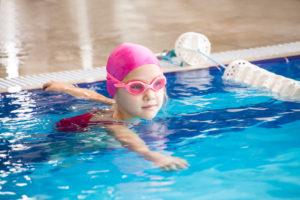Young swimmers benefit from physical drill representation
Swim coaches are always looking for the best drills for new swimmers. But no matter what drills you pick and how well you explain them, oftentimes the drills are disregarded by swimmers to your dismay. Why? Coaches usually lack an understanding of the style in which new material needs to be presented to children so they can understand and perform.
Children’s development
Between the ages of seven and eleven, children are in a unique developmental stage where they are transitioning from a mindset dominated by physical objects. Prior to age seven, children must see and touch and feel things in order to understand them; their ability to create an image in their minds just hasn’t developed yet. Around age seven, they start to be able to mentally construct images and situations in their minds and work toward their goals. This stage is called the concrete operational stage, according to Piaget.
Many studies have been run documenting this transition including a rather famous experiment involving two different sized glasses. Although both contained the same amount of liquid, children viewed the skinnier glass with the water level higher than the short, fat glass as containing more liquid. As children grew, they began to understand both held the same amount, just in different ways.
Coaching with concrete operational
Understanding the developmental stages of a child can benefit every coach, regardless of sport. There are three techniques that coaches should employ to help their athletes improve quickly.
Show, don’t tell
This can seem pretty obvious but those early in this stage oftentimes cannot put into practice verbal instructions right away without seeing it in action. When at all possible, show your athletes exactly what they need to do. If it’s a new batting stance for baseball, do it yourself, then make minor adjustments when the players try themselves.
Progress drills slowly
Too often, experienced athletes and coaches want to try to explain all the aspects of a drill or play right up front. Not only can this be a little difficult for any athlete to comprehend on the fly, young athletes can struggle much more with this comprehension.
Instead, introduce drills to athletes in small steps, proceeding to the next step only after they master the current step. This way, young athletes can easily focus on one, small aspect of a drill or change at a time. This helps tie the whole, larger picture together in their minds.
Use physical objects
Whenever possible, use physical objects to show your athletes what they need to do. Give them something to hold when teaching something new to make them think where the object needs to do for this new drill. A physical object is much easier for young athletes because they can see it and can see when their objective is being met.
Dills for new swimmers
So how does a coach properly apply the technique of concrete operational development to a coaching plan? Use kickboards and dryland to the fullest extent that you can.
Kickboard drills
Kickboards provide new swimmers with a host of opportunities to improve. A good kick is the foundation of a good stroke so it’s vital that we improve this wherever we can. But more importantly, a kickboard provides swimmers with the added assistance in the form of buoyancy. This allows you to teach hand positioning, breathing, and even kick drills all with one piece of equipment. Swimmers can visualize where their hands and head need to be relative to the kickboard, making it easier to understand what they should be working on.
Kickboards give coaches a lot of flexibility to progress through drills for new swimmers very slowly. In my article about how to teach the proper freestyle, I explain how to slowly progress swimmers to the proper freestyle using some of these concrete operational techniques. Most of the drills involve, slow and gradual shifts in kickboard drills to teach the proper body position, hand entry, and breathing.
Utilize drylands!
The benefits of drylands oftentimes go overlooked by coaches because of the extra work that goes into them. It is much harder to handle dozens of children out of the water, instead of in the water because they can scatter anywhere at a moment’s notice. But drylands pose a great teaching opportunity for coaches.
Some aspects of swimming can be confusing for swimmers to grasp, like relays. Trying to explain relays to new swimmers is like trying to explain the internet to a farmer from the 1800s. But, progressing swimmers through dryland activities to teach relays makes it so much easier. Letting them explore, watching the coaches, and having fun themselves makes your objective stick in their minds much easier. As an example, check out my progression to teaching new swimmers relays.
Drylands aren’t just for relays though! You can do an array of exercises to build core strength, teach aspects of meets, or just to have fun. But whatever you do, don’t overlook the benefits of drylands for those teaching moments that young swimmers so desperately need.
Remember: they’re learning
Utilizing these techniques will help you teach drills to new swimmers in a way that they won’t forget. But remember, this takes time. It may feel like some practices are a little chaotic and nothing gets accomplished, but when the kids are having a good time and can really understand what they need to do to get better, they will improve.

